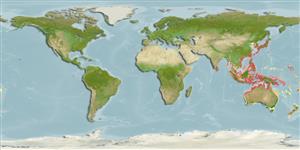Common names from other countries
Environment: milieu / climate zone / depth range / distribution range
Ecologia
. Tropical
Indo-West Pacific.
Length at first maturity / Tamanho / Peso / Idade
Maturity: Lm ? range ? - ? cm Max length : 2.2 cm SHL macho/indeterminado; (Ref. )
Found on exposed rocky shores, amongst Mytilisepta virgata beds (Ref. 126136). Occupy the mid and low intertidal zone. Graze on microalgae, encrusting macroalgae, and their spores. A non-homing limpet. Migrates to upper shore levels in winter (Ref. 127113). A fouling species attached to raft frames in mariculture zones (Ref. 127121). Shell serves as a substratum for the barnacle Amphibalanus amphitrite (Ref. 127116).
Life cycle and mating behavior
Maturidade | Reprodução | Desova | Ovos | Fecundidade | Larvas
Members of the order Neotaenioglossa are mostly gonochoric and broadcast spawners. Life cycle: Embryos develop into planktonic trocophore larvae and later into juvenile veligers before becoming fully grown adults.
Nakano, T. and T. Ozawa. 2007. (Ref. 3436)
Categoria na Lista Vermelha da IUCN (Ref. 130435)
Categoria CITES (Ref. 108899)
Not Evaluated
Not Evaluated
Ameaça para o homem
Harmless
Utilização humana
| FishSource |
Ferramentas
Fontes da internet
Estimates based on models
Preferred temperature
(Ref.
115969): 17 - 29.3, mean 28.5 (based on 1626 cells).
